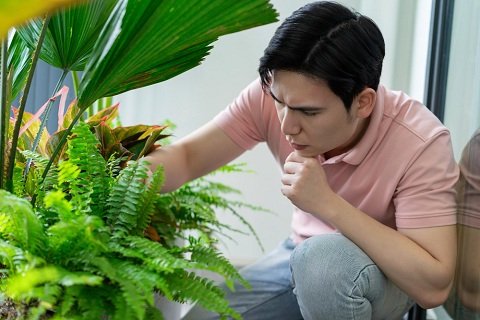ZZ plants (Zamioculcas zamiifolia) are celebrated for their robust nature and low-maintenance requirements, making them a popular choice for both novice and experienced plant enthusiasts. Despite their resilience, ZZ plants can face several common issues that may affect their health and appearance. This comprehensive guide will explore the most frequent problems, including yellowing leaves, overwatering and root rot, pest infestations, stunted growth, light-related issues, and diagnosing and treating common diseases. By understanding these problems and their solutions, you can ensure your ZZ plant remains healthy and vibrant.
Yellowing Leaves
Causes
- Overwatering: One of the most common reasons for yellow leaves is overwatering. ZZ plants store water in their rhizomes and do not require frequent watering. Excess moisture can cause the roots to suffocate and the leaves to turn yellow.
- Underwatering: While overwatering is a more frequent issue, underwatering can also cause leaves to yellow and drop. If the soil is too dry for extended periods, the plant will not get enough water to sustain its leaves.
- Nutrient Deficiency: A lack of essential nutrients, particularly nitrogen, can lead to yellowing leaves. ZZ plants need a balanced supply of nutrients to maintain their green color and overall health.
- Improper Light: Both too much and too little light can cause yellowing leaves. ZZ plants prefer indirect light and can tolerate low light, but they should not be exposed to direct sunlight for prolonged periods.
- Temperature Stress: Extreme temperatures, either too hot or too cold, can stress the plant and cause the leaves to yellow.
Solutions
- Adjust Watering Schedule: Ensure that you allow the soil to dry out between waterings. Check the moisture level by sticking your finger into the soil up to the first knuckle; if it feels dry, it’s time to water.
- Provide Balanced Fertilization: Use a balanced, water-soluble fertilizer once a month during the growing season (spring to early fall). Avoid over-fertilizing, as this can lead to nutrient imbalances.
- Optimize Light Conditions: Place your ZZ plant in a location with bright, indirect light. If natural light is insufficient, consider using artificial grow lights to supplement.
- Maintain Proper Temperature: Keep the plant in an environment with temperatures between 60°F and 75°F (15°C to 24°C). Avoid placing it near drafts or heat sources.
Overwatering and Root Rot
Causes
- Excess Watering: ZZ plants store water in their rhizomes and do not need frequent watering. Overwatering is a primary cause of root rot, as the roots become waterlogged and begin to decay.
- Poor Drainage: Using a pot without drainage holes or a poorly draining soil mix can trap water around the roots, leading to rot.
Symptoms
- Mushy, Brown Roots: Healthy roots are firm and white. If you notice mushy, brown roots when you inspect the plant, it is a sign of root rot.
- Yellowing and Wilting Leaves: As root rot progresses, the plant’s ability to take up water and nutrients diminishes, causing leaves to yellow and wilt.
- Foul Smell: Root rot often comes with a foul, earthy smell emanating from the soil.
Solutions
- Remove Affected Roots: If root rot is detected, carefully remove the plant from its pot and inspect the roots. Trim away any mushy, brown roots with sterilized scissors.
- Repot in Fresh Soil: Repot the plant in fresh, well-draining soil. A mix of potting soil with perlite or sand can improve drainage.
- Improve Watering Practices: Water the plant sparingly and allow the soil to dry out between waterings. Ensure the pot has drainage holes to prevent water from accumulating at the bottom.
Pest Infestations
Common Pests
- Spider Mites: These tiny pests can cause leaves to appear stippled or dusty and are often found on the undersides of leaves.
- Mealybugs: Mealybugs look like small, white, cottony clusters and can be found in leaf axils and on stems.
- Scale Insects: Scale insects appear as small, brown, immobile bumps on the leaves and stems.
Symptoms
- Discolored Leaves: Pests often cause leaves to discolor, yellow, or develop spots.
- Sticky Residue: Some pests, like mealybugs and scale insects, excrete a sticky substance called honeydew, which can attract mold.
- Stunted Growth: Severe infestations can hinder the plant’s growth by sucking sap and depriving it of nutrients.
Solutions
- Manual Removal: For small infestations, remove pests manually with a cotton swab dipped in alcohol.
- Insecticidal Soap: Apply insecticidal soap or neem oil to affected areas. Ensure thorough coverage of the undersides of leaves and stems.
- Isolation: Isolate the infested plant to prevent pests from spreading to other houseplants.
Stunted Growth
Causes
- Lack of Light: Insufficient light can slow down the growth of ZZ plants. Although they tolerate low light, they need some indirect light to grow optimally.
- Nutrient Deficiency: A lack of essential nutrients can lead to stunted growth. Regular feeding during the growing season is necessary.
- Improper Pot Size: Being root-bound in a pot that is too small can restrict growth.
- Pest Infestations: Pests like spider mites and mealybugs can damage plant tissues and stunt growth.
- Watering Issues: Both overwatering and underwatering can affect the plant’s growth. Consistent and appropriate watering is crucial for healthy development.
Solutions
- Increase Light Exposure: Move the plant to a brighter location with indirect light or supplement with grow lights.
- Fertilize Appropriately: Use a balanced fertilizer monthly during the growing season to ensure the plant gets adequate nutrients.
- Repot if Necessary: If the plant is root-bound, repot it into a slightly larger pot to give the roots more room to grow.
- Treat Pest Infestations: Address any pest issues promptly using appropriate treatments like insecticidal soap or neem oil.
- Optimize Watering Practices: Maintain a consistent watering schedule, allowing the soil to dry out between waterings to prevent both overwatering and underwatering.
Light-Related Issues
Causes
- Too Much Direct Sunlight: Direct sunlight can scorch the leaves, causing them to develop brown spots or edges.
- Too Little Light: Insufficient light can lead to leggy growth and pale leaves.
Symptoms
- Scorched Leaves: Brown, crispy edges or spots on the leaves indicate sunburn.
- Leggy Growth: Long, stretched-out stems with fewer leaves are a sign of inadequate light.
- Pale Leaves: Leaves may lose their vibrant green color and become pale if the plant is not getting enough light.
Solutions
- Adjust Light Exposure: Place the ZZ plant in bright, indirect light. Avoid direct sunlight, which can cause leaf burn.
- Supplement with Artificial Light: If natural light is limited, use artificial grow lights to provide the necessary illumination.
- Rotate the Plant: Rotate the plant periodically to ensure even light distribution and prevent one side from becoming too shaded.
Diagnosing and Treating Common Diseases
Common Diseases
- Leaf Spot: Caused by fungal infections, leaf spot appears as dark, irregular spots on the leaves.
- Powdery Mildew: This fungal disease presents as a white, powdery coating on the leaves.
- Root Rot: Often a result of overwatering, root rot causes the roots to become mushy and brown.
Symptoms
- Spots and Blotches: Dark spots or blotches on the leaves are indicative of fungal infections.
- White Coating: A white, powdery substance on the leaves signifies powdery mildew.
- Mushy Roots: Brown, mushy roots indicate root rot, often accompanied by yellowing leaves and a foul smell.
Solutions
- Remove Affected Leaves: Trim away any leaves showing signs of disease to prevent the spread.
- Improve Air Circulation: Ensure good air circulation around the plant to reduce humidity levels that promote fungal growth.
- Fungicidal Treatment: Apply a fungicide to treat fungal infections. Neem oil can also be effective in managing mildew and leaf spots.
- Repotting: For root rot, remove affected roots and repot the plant in fresh, well-draining soil.
Additional Tips for Healthy ZZ Plants
Regular Monitoring
- Routine Checks: Regularly inspect your ZZ plant for signs of stress, pests, or disease. Early detection allows for quicker intervention and less damage to the plant.
Clean Environment
- Dusting Leaves: Dust can accumulate on ZZ plant leaves, hindering photosynthesis. Clean the leaves with a damp cloth to keep them free from dust and grime.
- Sterilizing Tools: Always use sterilized tools when pruning or repotting to prevent the introduction of pathogens.
Appropriate Environment
- Consistent Temperature: Maintain a stable temperature between 60°F and 75°F (15°C to 24°C). Avoid placing the plant in areas with drafts or extreme temperature fluctuations.
- Moderate Humidity: While ZZ plants are not particular about humidity, maintaining moderate levels can support overall plant health. In dry climates, occasional misting or using a humidifier can be beneficial.
FAQs About Common Problems with ZZ Plants
Remove the plant from its pot, trim away the affected roots, and repot in fresh, well-draining soil. Adjust your watering habits to prevent future occurrences.
For small infestations, remove pests manually with a cotton swab dipped in alcohol. For larger infestations, use insecticidal soap or neem oil and isolate the plant to prevent spreading.
Ensure good air circulation, avoid overwatering, and keep the leaves dry. If necessary, treat with a fungicide or neem oil.
Yes, ZZ plants naturally have a slow growth rate. Providing optimal light, water, and nutrients can support healthy growth, but the plant will still grow at a moderate pace.
Conclusion
By understanding and addressing these common problems, you can ensure your ZZ plant remains a beautiful and resilient addition to your home or office. Regular monitoring and appropriate care practices will help you tackle any issues promptly and keep your ZZ plant thriving.














